
By Amanda W.J. Demopoulos, Research Benthic Ecologist - U.S. Geological Survey, Southeast Ecological Science Center
Jason D. Chaytor, Research Geologist - U.S. Geological Survey, Woods Hole Coastal and Marine Science Center
September 3-14, 2014
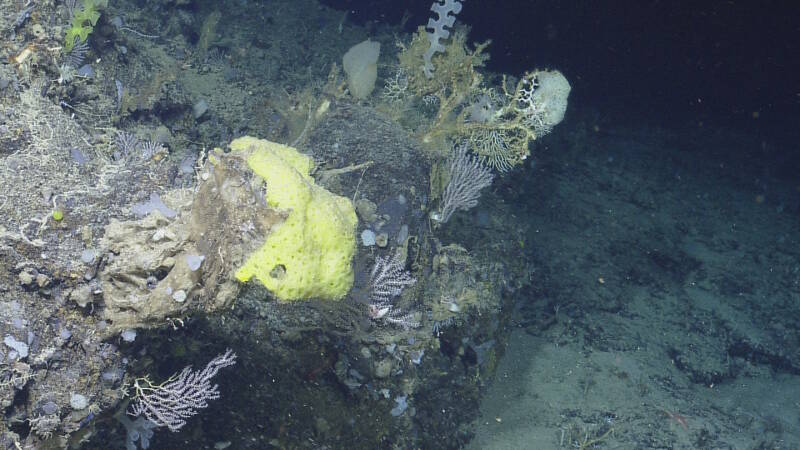
Hardbottom habitat as on Noroit Seamount provides substrate for the attachment of other species, including a diversity of sponges and octocorals. Image courtesy of the USGS Woods Hole Coastal and Marine Science Center. Download larger version (jpg, 1.3 MB).
From September 3 – 14, 2014, we will be exploring seamounts in the Anegada Passage, eastern Caribbean while on board the Exploration Vessel Nautilus. Findings from the expedition will help scientists better understand the geological history and hazard potential and to characterize the biology and ecology of explored areas.
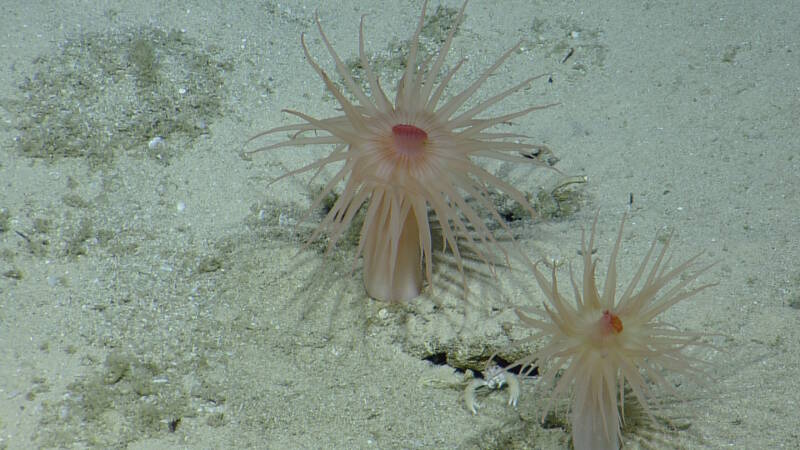
Two actiniarians (sea anemones), with a squat lobster peaking out of a small cave at the sediment surface. Image courtesy of the Ocean Exploration Trust. Download larger version (jpg, 1.1 MB).
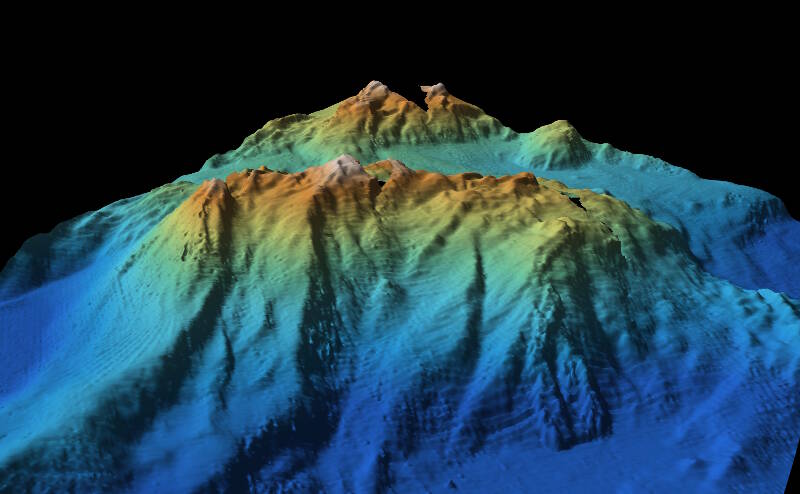
3D perspective view of Noroit Seamount looking east towards Conrad Seamount. Image courtesy of the U.S. Geological Survey. Download larger version (jpg, 1.2 MB).
While the structural architecture and tectonic history of the Anegada Passage and surrounding area have been studied for more than 50 years, there is no scientific consensus on the deformation history and current level of tectonic activity in the region.
Numerous large and innumerable smaller earthquakes have and continue to occur throughout the northeast Caribbean, representing a significant geohazard to the region. Shaking from high-magnitude earthquakes and, on occasion, resultant tsunamis, have caused significant damage to population centers throughout the region over recorded history (e.g., 1867 Virgin Islands earthquake-tsunami).
Although the Anegada Passage has been the location of two major earthquakes (1785 and 1867), the earthquake hazard and potential hazards from earthquake-driven tsunamis remains poorly known, primarily due to limited information about the location and characteristics of the current and recently active fault strands.
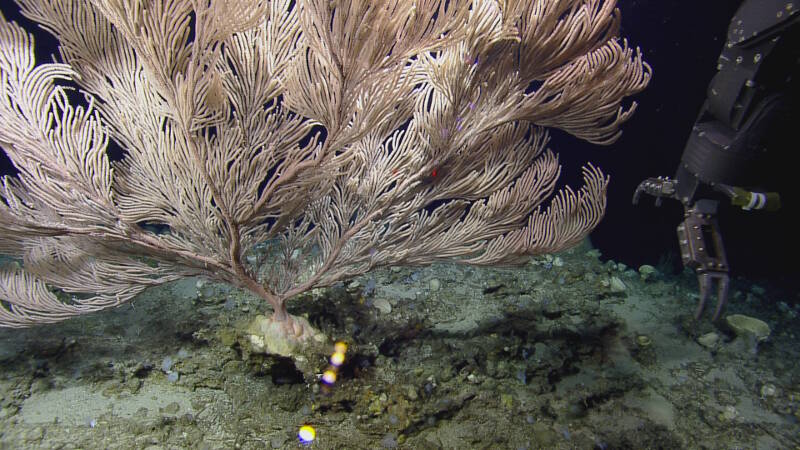
A large colony of a primnoid octocoral (Paracalyptrophora sp.) on Noroit Seamount. The Hercules manipulator arm is included for scale. Image courtesy of the Ocean Exploration Trust. Download larger version (jpg, 1.3 MB).
New bathymetric mapping, sub-bottom profiling, and visual investigation of fault traces during the cruise will expand our knowledge of potentially hazardous geological features in the region and provide officials in the region with better information on mitigation of earthquake and tsunami hazards.
Collection of a broad suite of rock samples from each of the targeted seamounts will provide key information in identifying connections between tectonic environments of the Great and Lesser Antilles.
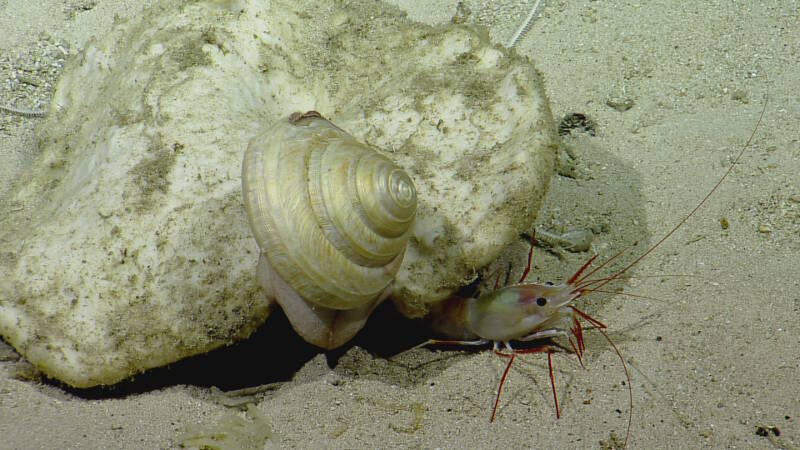
Sponges are important resources for other fauna, including gastropods (on left), shrimp (peaking out from underneath on right), and ophiuroid brittle stars (arms extending from underneath sponge in background). Image courtesy of the Ocean Exploration Trust. Download larger version (jpg, 1.2 KB).
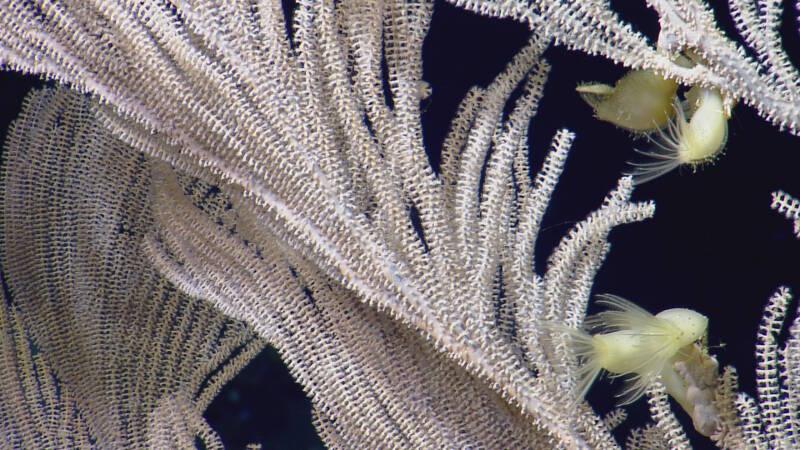
A close up of Paracalyptrophora sp. with polyps extending into the water column. This coral provides substrate for other animals, such as barnacles (on right). Image courtesy of the Ocean Exploration Trust. Download larger version (jpg, 1.2 MB).
Fishing, oil exploration and extraction, and mining have all expanded into the deep sea, affecting deep-sea communities. Because seamounts have myriad connections to surrounding marine ecosystems, any disturbance will have broad repercussions.
An assessment of the sensitivity or resilience of a particular ecosystem or species requires an understanding of their distribution, as well as some basic life history information. Our surveys will allow us to examine the distribution and abundance of coral species; explore and characterize the fauna associated with seamounts, including deep-sea corals, squat lobsters, and sediment infauna; and understand the degree to which these species depend on habitat features.
By combining size-frequency information from remotely operated vehicle transects with age-and-growth studies of corals from targeted collections, along with collections of other faunal communities, we will begin to understand the population dynamics of key habitat-forming species and understand more about faunal diversity, abundance, and community composition.
We are at a critical time to gather these data to help inform future protection of deep-sea ecosystems as human activities continue to expand in to deeper waters.